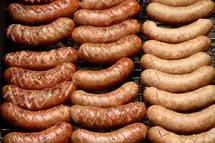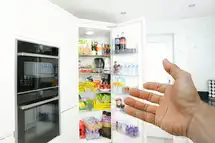What is the best bluetooth bbq thermometer?
Some of the best Bluetooth BBQ thermometers include the ThermoWorks Signals, the MEATER+, the Flame Boss 400, and Zip Thermometer. These devices all allow you to monitor your grill or smoker temperature remotely via an app on your smartphone or other mobile device.
How to Select the Best Bluetooth BBQ Thermometer for Your HACCP Program
What is the HACCP Food Safety Program?
Adherence to food safety norms is of paramount importance to any food business. Food safety norms safeguard the health and well-being of customers, and also ensure that a business doesn't get caught in litigation, face shutdown, or end up having to pay hefty fines.
It is therefore important for restaurants to be guided by a sound food safety program, like the Hazard Analysis Critical Control Point (HACCP).
HACCP is a food safety risk management system that is recognized internationally. It looks to analyze and control food hazards that may arise at any stage of the supply chain, whether it is in food production, procurement of raw materials, handling of raw materials, distribution, food preparation, or consumption.
The need for food businesses to be HACCP-compliant becomes all the more urgent in view of the grim foodborne disease burden in the US. According to Centers for Disease Control and Prevention (CDC) data, one in every six Americans falls prey to domestically-contracted foodborne diseases every year. These are caused by the action of over 30 known pathogens and some unspecified agents. The annual hospitalization and death rate resulting from foodborne illnesses is also worryingly high.
Thorough documentation of the principles of HACCP and the associated prerequisite programs make sure that restaurants know exactly what their food hazards are, when and at which stage they can appear, and how they can be eliminated.
How Does a Food Thermometer Fit Into the HACCP Program?
A foodservice business seeking to ensure food safety should determine critical control points (CCPs) and set critical limits. These are two extremely important HACCP principles.
The juncture at which a food safety hazard can be warded off, eradicated, or reduced to a manageable level is called a critical control point. The degree to which a chemical, biological, or physical parameter needs to be controlled at a CCP to ensure food safety, is termed a critical limit. Each CCP may, in fact, have several control initiatives. A control initiative, on the other hand, may relate to more than one critical limit.
Therefore, cooking can be considered a CCP. Cooking involves the heating of food, and this is a vital control initiative. Now, if you are cooking pork chops, you will need to cook them to a safe minimum internal temperature of 145 F so that foodborne pathogens can be eliminated. This essentially is the critical limit related to cooking pork chops. Similar critical limits are specified for various other ingredients as well.
Not just cooking, there may be other critical CCPs, such as storing and serving where maintaining the right temperature. Temperature control, therefore, is an integral part of control initiatives like refrigeration, freezing, and hot handling. The underlying objective is to prevent food from veering into the temperature range of 40-140 F (according to the United States Department of Agriculture) or 41 F-135 F (according to the National Restaurant Association's food safety training body, ServSafe), which is identified as the food temperature danger zone, where microbial activity peaks.
The critical limit associated with refrigeration of food is a temperature of 40 F or lower, and that associated with freezing is a temperature of 0 F or lower. Hot holding, or keeping meals hot during or prior to serving, has to be done at 140 F and above, and that is the critical limit related to hot holding.
Use thermometers to see if the temperature of the area where the food is kept has climbed above 90 F. You should not allow the food to stay out of the refrigerator for more than an hour. Also, with a thermometer check if the temperature of cold food items has fallen below 70 F, in which case the food has to be discarded.
Thermometers can also be used to make sure that food attains an internal temperature of 165 F during reheating.
Considering the importance of temperature, a food thermometer has a central role to play in a HACCP program. A thermometer's indispensability is premised on the fact that it's difficult to ascertain if food is ready and safe just by seeing, smelling, or touching it.
Food quality is a top concern for people.
You want to make sure your food is safe, but you don’t have the time nor the money to go through the lengthy process of cooking and testing each dish.
What is a Bluetooth Thermometer?
A food thermometer makes sure that the temperature of food stays outside the danger range.
However, a thermometer looks not only to ensure Food Safety but also seeks to help cooks prepare food to the required degree of doneness. The temperature chart for doneness is provided here-
- Medium-rare -- 145 F
- Medium -- 160 F
- Medium-well -- 175 F
- Well done -- 180 F
Therefore, since monitoring temperature is an integral part of cooking safe and tasty food, there is no scope for your attention to waver. If you forget about the meat after starting to grill, for example, there is a high chance that you will burn the meat. You could also end up taking the meat off the heat earlier than you should, resulting in undercooked meat.
However, smart technology today makes it possible to constantly and closely monitor the temperature of your cooking even when you are away from the grill/oven/smoker or when your attention wavers.
A Bluetooth grill / smoker thermometer does the job for you. This smart meat thermometer must be inserted into the fleshiest portion of the meat for an accurate reading. The thermometer links to your smartphone or tablet through Bluetooth to give you every relevant detail about your food in real time.
Bluetooth Bbq thermometers allow internal cooking temperature and ambient temperature to be tracked. A smartphone app connected to your Bluetooth/wireless meat thermometer will make food temperature-tracking an even easier and faster process.
Bluetooth thermometers alert you when you need to intervene, and when the cooking is complete. They don't need you to be physically present near the grill all the time to take temperature readings. You just need to check your phone from time to time to monitor food temperature.
How Does a Bluetooth Thermometer Work?
You'll understand how Bluetooth thermometers operate by looking at how a Bluetooth grill or smoker thermometer functions.
A Bluetooth meat thermometer needs to be inserted into the deepest part of the meat. This region is typically the middle of roasts and steaks, or a poultry bird's inner thigh. Be careful to avoid hitting bone, as that will produce a false temperature reading.
Wi fi BBQ probes need to be placed directly in the middle portion of the meat. Mount a dual probe on the grate directly. Make sure to insert a BBQ probe in the right way to prevent interference with temperature readings.
Some apps integrated with Bluetooth meat thermometers let users select meat types from several preset options. The cooking temperature range can be selected too.
The Bluetooth thermometer app allows the cook to track the internal temperature of the food and the ambient temperature of the oven at a glance. The temperature information updates on the app are in real time. This makes a Bluetooth thermometer a great tool to have in the kitchen. It is highly convenient to use and saves energy and time.
Bluetooth thermometers are better than instant read thermometers because the latter doesn't support remote temperature sensing and hence, can't be left in the food while it cooks, unlike Bluetooth/ wireless thermometers.
The projected time for the food to get cooked is displayed on the mobile app. As stainless steel temperature probes connected to the Bluetooth thermometers are inserted into the meat, the temperature-sensing gets automated and humans can take the backseat, intervening only when called upon by the app.
Going a step further in the use of smart technology for food temperature tracking, some companies selling Bluetooth food thermometers offer sleek charts and graphs for actionable insights on temperature tracking. Some smoker thermometer apps also proffer advice on ways of cooking meat to varying degrees of doneness.
Buying Tips - How to Pick the Right Bluetooth Thermometer
Considering the importance of Bluetooth thermometers, any business operating in the Food Industry has to select these thermometers carefully. Here are the points that are to be kept in mind-
1. The thermometer should contain at least two probes. However, if you typically load your BBQ grill with several food items or multiple cuts at once, you'll be better off using four to six probes.
2. A Bluetooth thermometer must be highly accurate, for even small temperature deviations can spoil a meal.
3. Bluetooth/ wireless grill thermometers or smoker thermometers should be simple enough to operate even by those who are not tech-savvy. This enables restaurants to save money and time training employees to use Bluetooth/wireless technology.
4. You should be able to receive real-time updates with the help of wireless/ Bluetooth BBQ thermometers. This quickens the cooking, and minimizes the time that the oven's lid has to be kept open.
5. Bluetooth grill or smoker thermometers often have to go through considerable stress and strain, and must therefore be built for durability.
Food quality is a major concern for many people.
Yet, you can never be sure if your food is cooked properly, or if it’s safe to eat.
5 Best Bluetooth BBQ Thermometers
1. Cooper-Atkins Blue2-
This food temperature monitor can send readings to Bluetooth-enabled handheld devices located up to 100 feet away in the line of sight. It can measure temperatures from -40 F to 999 F. Blue2 is compatible with any Type-K thermocouple probe, and can be seamlessly linked to the Zip HACCP software to make sure that the food contains no harmful microorganisms, and it isn't over- or under-cooked. The Zip HACCP solution is available on the Hubworks app store.
2. ThermoWorks Signals-
This Food Thermometer supports both Bluetooth and wi fi functionalities. It comes with splash-resistant molding that adds to its durability, and magnetic backing offers additional placement options. Signals' pro-series commercial grade temperature probes are highly accurate, respond faster, support broader temperature ranges, and have a long shelf-life. Signals has a line-of-sight range of 95 feet and a temperature range of -58 F to 572 F.
3. Meater Plus-
This smart meat thermometer comes with a Bluetooth repeater, a temperature probe, and two sensors. Its guided system takes you step-by-step through the entire cooking process. It also comes with an advanced algorithm that can compute cooking time and rest period. Cooking can be tracked wirelessly from a smartphone or tablet located up to 165 feet away. An internal food temperature of up to 212 F, and ambient temperature of up to 527 F can easily be measured.
4. ThermoPro TP-
Bluetooth meat thermometers of this series can calculate the internal temperature of several meat cuts simultaneously. The ThermoPro TP920 and ThermoPro TP25 meat thermometers have a range of 500 feet. Alarms can be set to send notifications when temperatures stray by 5-15 F. The temperature range of ThermoPro TP is 15.8 F to 572 F and supports preset temperatures for nine kinds of meat. Real-time temperature readings are presented as easily comprehensible graphs.
5. Weber iGrill 2-
The base unit includes two meat probes, and there is a scope to add two more. This smart grill thermometer allows several pieces of meat and smokers/grills to be monitored at once. It comes with a smartphone app and its range extends up to 150 feet. Each probe can be accorded a name, which makes monitoring easy. While the iGrill 2 can measure temperatures ranging from -22 F to 572 F, it can withstand up to 716 F.
Tips to Extend the Shelf-life of Your Thermometer
If you want your Bluetooth/ wireless meat thermometer to work well and for a long time, you need to maintain it properly. Since the probes are inserted into raw meat, they can contain bacteria. They also come in contact with spices, marinades, and other ingredients, which may breed bacteria. Using probes that have not been cleaned or sanitized can lead to cross-contamination and food poisoning.
Wash the probes with hot soapy water after every use, and dry them with a paper towel. Make sure the towel is clean. The probes can also be cleaned by rubbing with a cotton swab soaked in white vinegar. If you use the probes on multiple types of meat several times a day, alcohol wipes may be used for quick cleaning. Tough stains can be removed with cooking spray.
The thoroughly cleaned and dried probes must then be properly sanitized. Dip the prong of the thermometer into boiling water (at a temperature of 212 F or above) to eliminate any lingering pathogens. Don't immerse the entire thermometer into the water, though, as the appliance may not be water-proof.
Sanitization can also be done by rubbing the thermometer prong with a cotton swab soaked in isopropyl alcohol (with 60-70% alcohol content). The stem of the thermometer may alternatively be soaked in hydrogen peroxide or alcohol for a little while. Afterward, rinse the probes with cool water to remove any residual sanitizing agent.
The thermometer needle can also be disinfected using diluted chlorine bleach. Keep the needle soaked in this food-safe chlorine solution for 10 minutes. Then wash the needle with hot soapy water and allow it to dry.
Be careful not to use abrasive cleansers and sanitizers. Use a lint-free cloth for cleaning and drying the thermometer probes. Avoid using used kitchen towels as they may reintroduce harmful pathogens onto your food thermometer.
It's difficult to tell if your food is cooked when it's on the grill.
You don't want to overcook your meat, but you also don't want to undercook it.














































































































